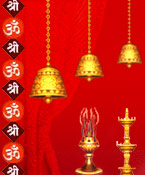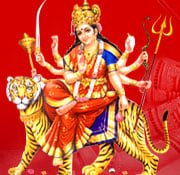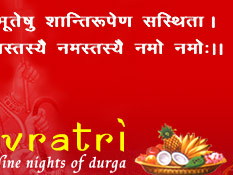



'Nav' means 'nine' and 'ratri' means 'night'. Thus, 'Navratri' means 'nine nights'. There are many legends attached to the conception of Navratri like all Indian festivals. All of them are related to Goddess Shakti (Hindu Mother Goddess) and her various forms. It is one of the most celebrated festivals of Hindu calendar, it holds special significance for Gujratis and Bengalis and one can see it in the zeal and fervor of the people with which they indulge in the festive activities of the season. Dandiya and Garba Rass are the highlights of the festival in Gujarat, while farmer sow seeds and thank the Goddess for her blessings and pray for better yield. In older times, Navratri was associated with the fertility of Mother Earth who feed us as her children.
The first three days of Navratri are dedicated to Goddess Durga (Warrior Goddess) dressed in red and mounted on a lion. Her various incarnations - Kumari, Parvati and Kali - are worshipped during these days. They represent the three different classes of womanhood that include the child, the young girl and the mature woman. Next three days are dedicated to Goddess Lakshmi (Goddess of Wealth and Prosperity), dressed in gold and mounted on an owl and finally, last three are dedicated to Goddess Saraswati (Goddess Of Knowledge), dressed in milky white and mounted on a pure white swan. Sweetmeats are prepared for the celebrations. Children and adults dress up in new bright-colored dresses for the night performances.
In some communities, people undergo rigorous fasts during this season that lasts for the nine days of Navratri. The festival culminates on Mahanavami. On this day, Kanya Puja is performed. Nine young girls representing the nine forms of Goddess Durga are worshiped. Their feet are washed as a mark of respect for the Goddess and then they are offered new clothes as gifts by the worshiper. This ritual is performed in most parts of the country. With commercialization, the festival has moved on to be a social festival rather than merely a religious one. However, nothing dampens the spirit of the devout followers of Goddess Durga, as they sing devotional songs and indulge in the celebrations of Navratri, year by year
Navratri (Nav Durga) is a nine-day festival of Hindus to honor the Mother Goddess. This celebration occurs twice a year: first in the spring, during March/April, and then another in the fall, during September/October based on the lunar cycle (9.24.2011 to 10.04.2011). "Navratri is not just a time to celebrate and of joy but is to attain Everlasting happiness, Peace and Anandam (Bliss) through self-discipline, self-control, and sacrifice. It is Nine Days of Living in Mother Goddess Consciousness and Experiencing Her Grace. Love

How do people celebrate the festival?
Different types of pujas and ceremonies are performed by different communities on each of the nine days. Many people (Hindus) observe fasting; eating only fruits, vegetables, and dairy products. They do specific sadhana, prayers, practice celibacy, and visit temples. Many temples, as well as people in their homes, offer special prayer programs with singing and music throughout the night, called "Jagran." On the final day, young girls up to age nine are worshipped as goddesses and given gifts as an offering of gratitude to mother goddess for her blessings. It is believed that at that age the girls have pure energy like mother goddess. In some parts of India, the idol of the Goddess Durga is immersed in the holy rivers on the tenth day (Dashehra).
What is the significance of Navratri (Nav Durga)?
The festival signifies the nine glorious aspects of the Divine Mother and is celebrated for nine days, not only in India but in many parts of the world.
Mother Goddess is also called Shakti, the energy of God. She is the energy of the Trinity, as the creative aspect of Lord Brahma, sustaining aspect of Lord Vishnu, and destructive aspect of Lord Shiva are all encompassed within Her.
The Divine Trinity of Goddesses Durga, Lakshmi, and Saraswati together represent feminine energy that provides protection, love, prosperity, and knowledge to all their devotees. Goddess Durga is known to remove evil, misery, and pain from our lives. Goddess Lakshmi is the Goddess of Wealth and Goddess Saraswati is also known as the Goddess of Knowledge. Nav Durga is therefore a special time to worship and sing the glories of the Goddesses, and pray for good health, prosperity, purity of mind, love, peace, and Anandam/bliss. As large numbers of people pray during this time, the collective energy becomes very powerful and it is said that the prayers offered are often heard by the Goddesses.
 Who is Durga Maa?
Who is Durga Maa?
Durga Maa, the symbol of Pure Love, Pure Energy (Divine Shakti) and Light within (Jyoti).
Durga Maa, the Supreme Goddess, is a symbol of Pure Love, Courage (Shakti), Light within and Bliss. She represents the power of the Supreme Being that preserves moral order and righteousness in the creation. The Sanskrit word Durga means fort or a place that is protected and thus difficult to reach. Durga, also called Divine Shakti, protects mankind from evil and misery by destroying evil forces such as selfishness, jealousy, prejudice, hatred, anger, and ego. She is referred to as Universal Mother and the mother of Ganesh. Sometimes she is also referred to as Parvati, Lakshmi, and Saraswati because she is also an incarnation of Saraswati or Lakshmi. She is also known as Maha-mayi (Great, Terrific) because she is a composite goddess of different elements of many Gods and Goddesses. Durga Maa is depicted as a warrior woman with eight hands carrying weapons of almost all the Devas, assuming mudras, or symbolic hand gestures, and riding a lion or a tiger.

Navratri Aarti
Jai Ambe Gauri MaiyaaJai Ambe Gauri maiyaa, jai Shyaama Gauri
Nishdin tumko dhyaavat, Hari Brahmaa Shivji,
Jai Ambe Gauri maiyaa, jai Shyaama Gauri
Maang sindur biraajat, tiko mrigmadko,
Ujjvalse do naina, chandravadan niko,
Jai Ambe Gauri maiyaa, jai Shyaama Gauri
Kanak saman kalevar, raktaambar raje,
Raktapushp galmaala, kanthhaar saje,
Jai Ambe Gauri maiyaa, jai Shyaama Gauri
Kehari vaahan rajat, khadg khappar dhari
sur nar munijan sevat, tinke dukhahaari,
Jai Ambe Gauri maiyaa, jai Shyaama Gauri
Kaanan kundal shobhit, naasagre moti
Kotik chandra divaakar, samraajat jyoti,
Jai Ambe Gauri maiyaa, jai Shyaama Gauri
Shumbh- nishumbh vidaare, MahishaaSur ghatia
Dhumra-vilochan naina, nishdin madmati
Jai Ambe Gauri maiyaa, jai Shyaama Gauri
Brahmaani, Rudraani tum Kamalaa Raani,
Agam-nigam bakhaani. tum Shiv patraani,
Jai Ambe Gauri maiyaa, jai Shyaama Gauri
Chaunsath yogini gaavat, nritya karat Bhairon,
Baajat tab mridanga, aur bajat damru,
Jai Ambe Gauri maiyaa, jai Shyaama Gauri
Tum ho jag ki maataa, tum hi ho bhartaa,
Bhaktan ki dukh hartaa, sukh sampati kartaa,
Jai Ambe Gauri maiyaa, jai Shyaama Gauri
Bhujaa char ati shobhit, var mudraa dhaari,
Manvaanchhit phal paavat, sevak nar naari,
Jai Ambe Gauri maiyaa, jai Shyaama Gauri
Kanchan thaal virajat, agaru kapur baati
Malketu men rajat, kotiratan jyoti,
Jai Ambe Gauri maiyaa, jai Shyaama Gauri
Ma Jay Aadya Shakti
Mataji ni aarti.. Jaya aadhya shakti,
Maa jaya aadhya shakti,
Akhand brahmand nibhavyan (2x),
Padave pragatyan ma,
Om jay om jay om maa jagadambe
Dwitiya bay swaroop,
Shiva shakti janoo,
Maa shiva shakti janoo,
Bramha ganapati gaavun (2x),
Har gaavun har maa
Om jay om jay om maa jagadambe
Tritiya tran swaroop,
Tribhuvan man betha,
Maa tribhuvan man betha,
Traya thaki taraveni (2x),
Tun taraveni maa,
Om jay om jay om maa jagadambe
Chote chatura mahalaxmi,
Sacharachar vyapya,
Maa sacharachar vyapya,
Char bhuja chau deesha (2x),
Pragatya dakshina maa,
Om jay om jay om maa jagadambe
Panchame pancha rushi,
Panchame goon padame,
Maa panchame goon padame,
Pancha sahast tyan sohiya (2x),
Panche tatwo maa,
Om jay om jay om maa jagadambe
Shasthi tun narayani,
Mahisasur maaryo,
Maa mahisasur maaryo,
Nar naree na roope (2x),
Vyapa saghade maa,
Om jay om jay om maa jagadambe
Saptami sapta pataal,
Sandhya saveetri,
Maa sandhya saveetri,
Gau ganga gayatree (2x),
Gauri geeta maa,
Om jay om jay om maa jagadambe
Asthami astha bhooja,
Aayee ananda,
Maa ayee ananda,
Surinar moonivar janamya (2x),
Devo daityo maa,
Om jay om jay om maa jagadambe
Navami navakul naag,
Seve navadurga,
Maa seve navadurga,
Navaratri naa poojan,
Shivratri naa arachan,
Kidha nar brahma,
Om jay om jay om maa jagadambe
Dashami dash avatar,
Jay vijaya dashmi,
Maa jay vijaya dashmi,
Rame ram ramadya (2x),
Ravan rodyo maa,
Om jay om jay om maa jagadambe.
Ekadashi agiyarash,
Katyayani kaamaa,
Maa katyayani kaamaa,
Kaam doorga kalika(2x),
Shyama ne raama,
Om jay om jay om maa jagadambe.
Barase bala roop,
Bahuchari amba maa,
Maa bahuchari amba maa,
Batuk bhairava sohiye (2x),
Tara chhe tuja,
Maa jay om jay om maa jagadambe.
Terase tulaja roop,
Tun taruni mata,
Maa tun taruni mata,
Brahma vishnu sadashiv (2x),
Guna tara gata,
Om Jay Om Jay Om Maa Jagadambe
Chaudashe chauda roop,
Chandi chamunda,
Maa chandi chamunda,
Bhava bhakti kain aapo,
Potani kai stapho,
Sinha vahani,
Maa jay om jay om maa jagadambe.
Shivashakti ne aarti,
Je koyee gaashe,
Maa je bhaave gaashe,
Bhane shivananda swami(2x),
Sukha sampati thaassey,
Har kailashe jaashe,
Maa amba dukha harashe,
Om jay om jay om maa jagadambe
Eke ek swaroop,
Antar nava darasho,
Maa antar nava darasho,
Bhola bhoodar na bhajata,
Maa amba ne bhajata,
Bhavasaagar tarasho,
Om jay om jay om maa jagadambe
Bhava na janoo,
Bhakti na janoo seva,
Maa na janoo seva,
Mata na daas ne raakho(2x),
Charnamrit leva,
Om jay om jay om maa jagadambe.












0 comments:
Post a Comment